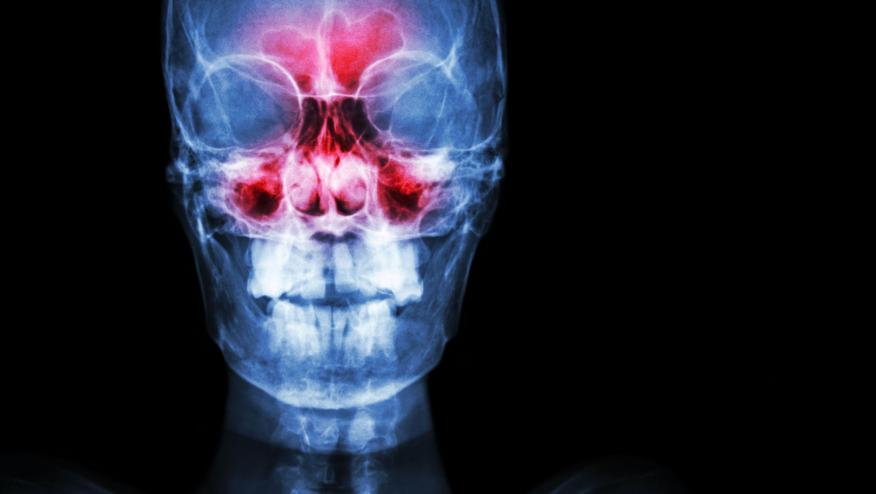Predicting Vasculitis Relapse Save

Scores on a patient-reported sino-nasal symptom questionnaire were associated with subsequent flares of one type of ANCA-associated vasculitis (AAV), researchers said.
Patients with granulomatosis with polyangiitis (GPA) who scored high on the 22-item Sino-Nasal Outcome Test (SNOT-22)o but otherwise had low disease activity later relapsed at a significantly higher rate than in patients with low scores, according to Ellen Romich, MD, MS, of the University of Pennsylvania in Philadelphia, and colleagues.
These higher scores preceded relapse by "months to years," the group reported in Arthritis Care & Research.
Sino-nasal symptoms were more common generally in AAV patients, Romich and colleagues observed. In their study, this was true even for patients otherwise considered in remission: their scores averaged 20, compared with a mean of 5 in healthy controls.
That was not unexpected, as the small-vessel inflammation that defines AAV (ANCA stands for antineutrophil cytoplasmic antibody) often involves the sino-nasal region, with such symptoms as chronically runny nose and sinus blockage. However, it hasn't been clear to what extent these symptoms might presage a full-blown relapse in patients with otherwise well-controlled disease.
For the current study, Romich's group drew on data from a longitudinal cohort study at the University of Pennsylvania that ran from 2016 to 2022. AAV is actually a group of related conditions that include GPA, eosinophilic granulomatosis with polyangiitis (EGPA), and microscopic polyangiitis (MPA). A total of 168 patients were included, along with 51 healthy controls.
Participants were administered the SNOT-22, in which the person assigns a score of 0 to 5 for each of 22 possible symptoms, such that the total score could range up to 110. Symptoms aren't strictly confined to sino-nasal problems -- dizziness, fatigue, sleep difficulties, mood, and productivity are covered as well.
Mean patient age was 55; it was 59 among controls. Just under 60% were women and nearly all were white. Mean AAV duration was about 3 years. Roughly half had experienced a previous disease flare, and more than half of those involved sino-nasal symptoms.
During their time in the cohort, patients averaged a little less than five visits. Most patients were free of major symptoms except for those affecting the nose and sinuses; such symptoms were present during about two-thirds of visits, and about 20% of visits were exclusively for these symptoms.
SNOT-22 items were divided into five categories: rhinologic (six items), extranasal (three), ear/facial (five), psychological (six), and sleep (six), within which the individual item scores were summed. Means for each category were:
- Rhinologic: 8
- Extranasal: 4
- Ear/facial: 4
- Psychological: 10
- Sleep: 9
The strongest relationships between high SNOT-22 scores and subsequent relapse risk were for GPA, with a hazard ratio of 2.7 (95% CI 1.2-6.2) for total score when the cut-point was put at 41. It was somewhat weaker, and not statistically significant, for EGPA (HR 1.5, 95% CI 0.4-5.3). There were too few MPA patients (19) to yield meaningful results, and most analyses excluded them.
GPA and EGPA diagnoses also differed with respect to which symptom categories were most associated with later relapse. In GPA, rhinologic and extranasal symptoms were the chief drivers, with hazard ratios of 3.6 and 3.7 for cut-points of 5 and 3, respectively. Ear/facial symptoms appeared more important for EGPA patients, with a hazard ratio of 4.1 for a cut-point of 3 (P=0.1).
Particularly in the GPA subgroup, SNOT-22 scores were higher for relapsing patients than in those who remained relapse-free throughout the study period. At GPA patients' first visit, scores averaged nearly 40 for those who later relapsed versus about 22 for those who didn't. This was not really the case in the EGPA group, whose SNOT-22 scores didn't differ between relapsing and non-relapsing patients until much later in follow-up, and then not by as much.
The study came with several limitations, most importantly the small sample size that left many analyses underpowered. Also, it was not possible to distinguish symptoms as originating with active disease versus permanent damage, or from other possible causes such as infection and allergies. Potential effects of treatments that patients were receiving (most were on a steroid or some type of disease-modifying drug) were also not evaluated.
Romich and colleagues suggested that modifying the SNOT-22 instrument to be more focused on AAV -- with items on nasal crusting, bleeding, and deformity, for example -- might strengthen its predictive value.
"Future studies are needed to determine if the SNOT-22 score can be used for selective escalation or de-escalation of immunosuppressive therapy or assessment of treatment response," the researchers concluded.
Source Reference:Romich E, et al "Patient-reported sinonasal symptoms and risk of relapse in ANCA-associated vasculitis" Arthritis Care Res 2024; DOI: 10.1002/acr.25329.








If you are a health practitioner, you may Login/Register to comment.
Due to the nature of these comment forums, only health practitioners are allowed to comment at this time.